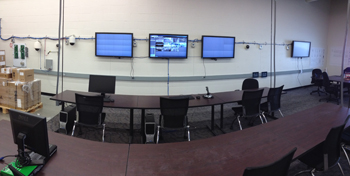
|
|
PHOTO COURTESY OF SDI The Minneapolis-Saint Paul International Airport has the 12th busiest airfield in the United States. It is working with SDI to enhance and maximize security capabilities, including the migration of the airport’s analog video system to an entirely digital video system and the implementation of a highly integrated PSIM. Upon completion, the security system will include more than 2,500 cameras, 100 workstations and a variety of video analytic and informational interface programs. |
The Minneapolis-Saint Paul International Airport (MSP) has the 12th busiest airfield in the United States and serves more than 33 million passengers a year. A joint civil-military airport, MSP is also home to the Minneapolis–Saint Paul International Airport Joint Air Reserve Station, supporting both Air Force Reserve Command and Air National Guard flight operations. Airlines out of Minneapolis–Saint Paul International Airport serve 135 nonstop markets from MSP, including 120 domestic and 15 international markets. Like many other airports, MSP interconnects with several other forms of transportation, as well.
One of the challenges it faces in securing the airport and its passengers is ensuring that the security system is changing with the airport’s growth. Part of that growth means upgrading the airport’s enterprise security system.
SDI (System Development Integration, LLC), a systems integrator specializing in life-cycle airport security technologies and infrastructure, is working with MSP airport security staff to enhance and maximize security capabilities, including the migration of the airport’s analog video system to an entirely digital video system and the implementation of a highly integrated Physical Security Information Management (PSIM). Upon completion, the security system will include more than 2,500 cameras, 100 workstations and a variety of video analytic and informational interface programs.
The new Integrated Video and Information Systems Network (iVISN) Surveillance System program will be done in two phases. Within its first phase, the SDI Team already has built an iVISN Test Lab to establish a complete test environment, which included installation of a Verint PSIM system, an integrated GIS mapping system and a Verint Nextiva Digital Video Management System (VMS) capable of supporting thousands of cameras on a virtualized, single-server environment. SDI successfully integrated the test systems with MSP’s existing Security and Access Control System (SAACS) and Multi-User Flight Information Display System (MUFIDS) environments. The MUFID integration provides a real-time MUFIDS display as a flexible overlay to the live video screen, providing instantaneous flight verification information on gate cameras, while associating multiple cameras per gate.
“The importance of constructing the iVISN test lab was to provide an environment that mirrors the production environment, allowing for full lifecycle testing in a realistic setting,” said SDI’s Dan Buchman, project manager. “All the solutions developed in the test lab were exposed to a level of testing that emulated a true production (installed) environment, thus reducing the exposure once promoted to production. Applications that were built and deployed in the test lab included a full-scale access control system, a complete analog camera infrastructure and IP cameras deployed throughout the airport concourses in order to capture realistic video. The compilation of these applications provided SDI the necessary environment and tools to conduct a very thorough system testing cycle.”
For Minneapolis-Saint Paul International Airport, SDI was also able to create a customized interface to the airport’s existing legacy analog system, allowing operators full control of cameras through the new system. This was much more than just adding encoders to move video,” says MSP CIO David Ruch. “It allows us to migrate all 1,800 existing cameras into the new system without having to undergo a complete rip and replace. This increases program ROI, and creates a much more manageable environment for our IT department to support.”
As a separate and parallel project, the SDI Team deployed the Nextiva VMS at two newly constructed checkpoints and their baggage handling systems, including high-definition cameras and all underlying network infrastructure. The new technologies have been well received by the TSA, Airport Police and Emergency Communications Center personnel. As a result, these stakeholders can now rapidly detect live security breaches and other threats. The improved quality of the video, combined with the powerful new investigation tools and functionality of the software, have greatly enhanced the airport’s video forensic capabilities.
“The new system will provide significant benefits to the airport not only for traveler security but also for improved operations,” Ruch added.

|
|
PHOTO COURTESY OF SDI At MSP, the SDI team created a test lab to provide an environment that mirrors the production environment, allowing for full lifecycle testing in a realistic setting. |
“It’s about walking in their shoes,” said Mark Moscinski, SDI’s senior vice president of Safety and Security. “Our team understands all aspects of the user environment. They leverage technology to make for a better user experience, like integrating Nextiva to Active Directory. Once initial user rights are set up in Nextiva, MSP IT administrators and help-desk staff can immediately manage users and groups with the tools they are already familiar with. This adds tremendous value to the program.”
Phase 2 of the project will include the deployment of more than 2,000 new cameras and associated workstations, infrastructure, network equipment, video analytics and video storage. Additional systems will be integrated with the Nextiva PSIM, including MSP’s building automation system, computer aided dispatch system, and license plate recognition system.
Phase 2 also takes the work done in the test lab to the real environment, said Buchman. “Phase 2 consists of integrating and configuring existing analog cameras into the Nextiva VMS in a production environment. This integration is being accomplished by utilizing custom software that was developed and tested in the test lab environment. This integration uses an intelligent load-balancing algorithm to maximize use of available keyboard connections to the matrix. This solution allows the operator to view and control existing analog cameras through both the existing analog camera infrastructure as well as through Nextiva Review.”






